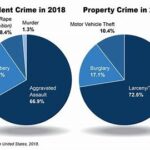Property Theft in the USA: Understanding the Causes, Impacts, and Solutions
Abstract:
Property theft is a pervasive issue in the United States, encompassing a wide range of offenses from petty theft to sophisticated cybercrimes. This essay provides a comprehensive examination of property theft in the USA, exploring its causes, impacts on individuals and society, as well as potential solutions. Drawing upon academic research, statistical data, and case studies, this essay aims to shed light on the complexities of property theft, its implications for law enforcement and public policy, and the measures that can be taken to prevent and address this persistent challenge.
1. Introduction
Property theft is a prevalent crime that affects individuals, businesses, and communities across the United States. Defined as the unlawful taking of another person’s belongings or assets, property theft encompasses a wide range of offenses, including burglary, larceny, robbery, and identity theft. From petty thefts in retail stores to sophisticated cybercrimes targeting financial institutions, property theft poses significant challenges to law enforcement, businesses, and consumers alike. This essay examines the causes, impacts, and potential solutions to property theft in the USA, highlighting the complex interplay of socioeconomic factors, technological advancements, and legal frameworks that shape this pervasive phenomenon.

2. Types of Property Theft
Property theft encompasses a variety of offenses, each with its own distinct characteristics and implications. Common types of property theft include:
- Burglary: The unlawful entry into a building or structure with the intent to commit theft or another felony. Burglaries can occur in residential, commercial, or industrial settings and may involve forced entry or unauthorized access.
- Larceny/Theft: The unlawful taking and carrying away of someone else’s property with the intent to permanently deprive the owner of its possession. Larceny encompasses a broad range of offenses, from shoplifting and pickpocketing to car theft and embezzlement.
- Robbery: The theft of property or money from a person or entity through the use of force, violence, or intimidation. Unlike burglary, which involves unlawful entry, robbery occurs in the presence of the victim and often involves direct confrontation or threat of harm.
- Identity Theft: The unauthorized use of someone else’s personal information, such as their name, Social Security number, or financial account details, to commit fraud or other criminal activities. Identity theft can result in financial loss, damage to credit scores, and reputational harm for victims.
- Cybercrime: The use of computers, networks, or digital devices to commit theft or fraud. Cybercrimes can take various forms, including phishing scams, malware attacks, and data breaches, and often target sensitive information such as financial data, passwords, and personal records.
3. Causes of Property Theft
Property theft is influenced by a combination of individual, societal, and environmental factors that contribute to its occurrence. Some common causes include:

- Poverty and Economic Inequality: Socioeconomic disparities and lack of access to resources can drive individuals to engage in property theft as a means of survival or economic gain. Limited job opportunities, inadequate social support, and systemic inequalities can exacerbate feelings of desperation and lead individuals to resort to criminal behavior.
- Substance Abuse and Addiction: Substance abuse, including drug addiction and alcoholism, can impair judgment, lower inhibitions, and increase the likelihood of engaging in impulsive or criminal behavior. Individuals struggling with addiction may turn to property theft to finance their substance use or alleviate withdrawal symptoms.
- Opportunistic Behavior: Some instances of property theft occur as crimes of opportunity, where individuals take advantage of vulnerable targets or lax security measures. Opportunistic thieves may target unlocked vehicles, unattended belongings, or poorly secured properties with minimal risk of detection or apprehension.
- Technological Advancements: The proliferation of technology and digital connectivity has facilitated new forms of property theft, such as cybercrimes and identity theft. Advances in computing, telecommunications, and information technology have created new opportunities for criminals to exploit vulnerabilities in online systems and defraud unsuspecting victims.
4. Impacts of Property Theft
Property theft can have far-reaching consequences for victims, perpetrators, and society as a whole. Some common impacts include:
- Financial Loss: Property theft can result in significant financial losses for individuals, businesses, and government agencies. Victims may incur expenses related to replacing stolen property, repairing damage to their belongings or property, and addressing the aftermath of identity theft or fraud.

- Emotional Distress: Being a victim of property theft can cause emotional trauma, stress, and anxiety for individuals and families. The violation of personal space, loss of cherished belongings, and feelings of vulnerability can have lasting psychological effects on victims, impacting their sense of security and well-being.
- Disruption of Daily Life: Property theft can disrupt the daily routines and activities of victims, creating inconvenience, inconvenience, and disruption in their lives. Victims may experience disruptions in work, school, or personal relationships as they deal with the aftermath of theft, file reports with law enforcement, and take steps to protect themselves from future incidents.
- Erosion of Trust: Property theft can erode trust within communities, leading to heightened suspicion, fear, and mistrust among neighbors, businesses, and institutions. A perceived lack of safety and security can undermine social cohesion and deter individuals from participating in community activities or supporting local businesses.
5. Strategies for Prevention and Intervention
Preventing and addressing property theft requires a multifaceted approach that addresses underlying causes, strengthens security measures, and promotes collaboration between law enforcement, businesses, and community organizations. Some effective strategies include:
- Community Policing: Engaging with communities and fostering positive relationships between law enforcement officers and residents can help deter property theft and promote cooperation in reporting and investigating crimes. Community policing initiatives, such as neighborhood watch programs and crime prevention workshops, empower residents to take an active role in safeguarding their neighborhoods and promoting public safety.
- Target Hardening: Implementing security measures, such as locks, alarms, and surveillance cameras, can deter property theft and reduce the risk of victimization. Businesses and homeowners can take proactive steps to secure their properties and belongings, making them less vulnerable to opportunistic thieves and burglars.

- Education and Awareness: Raising awareness about the risks of property theft and providing information on crime prevention strategies can empower individuals to protect themselves and their communities. Educational initiatives, public awareness campaigns, and outreach efforts can help disseminate information about common types of property theft, warning signs to watch for, and steps to take in the event of victimization.
- Legislative and Regulatory Measures: Enacting and enforcing laws and regulations that deter property theft and hold perpetrators accountable can help reduce crime rates and protect victims’ rights. Legislators can strengthen penalties for property theft offenses, support initiatives to address root causes such as poverty and substance abuse, and allocate resources to support law enforcement efforts and victim services.
6. Conclusion
Property theft is a pervasive and complex issue that poses significant challenges to individuals, businesses, and communities across the United States. By understanding the causes, impacts, and solutions to property theft, stakeholders can work together to prevent and address this persistent problem. Through collaborative efforts between law enforcement, businesses, community organizations, and policymakers, it is possible to create safer and more secure environments where individuals can thrive and prosper without fear of victimization.



